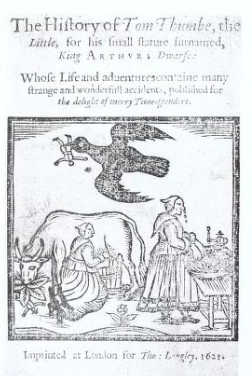|
So after my last rather depressing post, I wanted to go in a lighter direction – namely, what was the original version of Tom Thumb like? Nobody really set out to collect English fairytales until after the Brothers Grimm got the bandwagon going in the 1800s. So we basically don’t have anything until very late in the game. Other countries tend to have several recorded variants of the Thumbling tale type. England has one very famous variant and that’s it. Naturally, I tried to go back to the earliest version, but even that is pretty confusing. The oldest surviving version of Tom Thumb, The History of Tom Thumbe, the Little, signed by R.I. (possibly Richard Johnson), was printed in 1621. However, it could be older, because the title page woodblock shows signs of wear (Opie, The Classic Fairy Tales, 30). One very big blank space that makes research problematic: none of these chapbooks include the date that the story was originally published. And that adds another wrinkle – which version came first? R.I.’s long prose version, which we know was in print at least by 1621? Or the metrical Tom Thumbe, His Life and Death, of which the earliest surviving print is from 1630? We don’t know when either was originally set to type! And there were probably others, long since lost.
Maybe there are contextual clues, though. R.I.’s version is a satire. It includes many elements that never appear in any other version – like magical gifts from the Fairy Queen, an encounter with the pygmy king, and a battle with the giant Garragantua (a common figure in pop culture at the time). The metrical version is much easier to find, and its verses are quoted even in modern retellings. So in the long run, it has been miles more popular. Perhaps R.I.’s version is based on the metrical version, or perhaps both are separate adaptations of the oral tale. R.I. also makes mention that this already is a very old and well-known story. I think it originated in an oral tale very similar to the thumblings of other countries, like the Grimms’ Daumling. Then someone, possibly R.I., added a section which was basically crossover fanfiction with King Arthur. R.I. refers to the character as “Little Tom of Wales,” so perhaps the story came from Wales – though before that, who knows. Tom Thumb is probably much younger than the tales of King Arthur, which have absolutely nothing resembling his story. ( King Arthur is in all Tom Thumb stories; Tom never appears in King Arthur stories.) Incidentally, however, Arthur originates in Welsh lore. If Tom Thumb truly did come from Wales, then that would be an interesting connection. So, what would the story have looked like before Arthur was added? It’s hard to say. There could have been a king whom Arthur replaced. The swallow cycle was probably in there in some form or other. But the story seems to have been so well-known that no one at the time ever thought to describe it – they could namedrop it and everyone would know what they were talking about. This is what happens in the earliest surviving mention is in 1579, in William Fulk’s Heskins Parleament Repealed, with the line "a little child like Tom Thumb." But in 1611, in Coryat’s Crudities by James Field, we finally get something more meaty: “Tom Thumbe is dumbe, untill the pudding creepe, in which he was intomb'd, then out doth peepe." In the fairytale, Tom is cooked into a pudding and has to break his way out, frightening a tinker in the process. We can know that even before 1621, one part of the story that definitely existed was Tom’s adventure with the pudding. In comparison, there is a story called Dathera Dad from Derbyshire, England. It’s usually grouped with Gingerbread Man variants, but it is near-identical to Tom’s adventure with the pudding and the tinker. Could this be evidence of a more widespread, forgotten English thumbling narrative? But Fielding might be referring to one of the print versions, not the oral version – remember, we don’t know the original publication dates! Ultimately, unless someone makes some groundbreaking new discovery, we can’t know anything for sure. Notes: There are a few books that reprint R.I.'s Tom Thumb. One is Merie Tales of the Mad Men of Gotam and The History of Tom Thumb, a version edited by Curt F. Buhler and put out by the Renaissance English Text Society. Another, available on Open Library, is The Classic Fairy Tales, by Iona and Peter Opie. Text copyright © Writing in Margins, All Rights Reserved
0 Comments
Leave a Reply. |
About
Researching folktales and fairies, with a focus on common tale types. Archives
July 2024
Categories
All
|
Writing in Margins

 RSS Feed
RSS Feed
